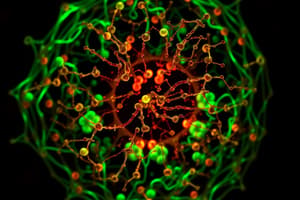Podcast
Questions and Answers
What is the primary function of the nuclear lamina?
What is the primary function of the nuclear lamina?
- To transport molecules between the nucleus and cytosol
- To replicate DNA
- To provide structural support for the nuclear envelope (correct)
- To synthesize proteins
What is the relationship between the outer nuclear membrane and the endoplasmic reticulum (ER)?
What is the relationship between the outer nuclear membrane and the endoplasmic reticulum (ER)?
- They are separate structures with no connection
- The ER is a part of the outer nuclear membrane
- The outer nuclear membrane is continuous with the ER (correct)
- The outer nuclear membrane is a part of the ER
What is the purpose of the nuclear pore complexes?
What is the purpose of the nuclear pore complexes?
- To synthesize proteins
- To replicate DNA
- To provide structural support for the nuclear envelope
- To conduct bidirectional traffic between the cytosol and the nucleus (correct)
What is the role of the transmembrane proteins in the inner and outer nuclear membranes?
What is the role of the transmembrane proteins in the inner and outer nuclear membranes?
What is the function of the ribosomes on the outer nuclear membrane?
What is the function of the ribosomes on the outer nuclear membrane?
What is the destination of the proteins made on the ribosomes on the outer nuclear membrane?
What is the destination of the proteins made on the ribosomes on the outer nuclear membrane?
What is the function of the proteins made on the ribosomes on the outer nuclear membrane?
What is the function of the proteins made on the ribosomes on the outer nuclear membrane?
What is the direction of protein transport in the perinuclear space?
What is the direction of protein transport in the perinuclear space?
What triggers the disassembly of the nuclear lamina during mitosis?
What triggers the disassembly of the nuclear lamina during mitosis?
What is the result of dephosphorylation of the lamins during mitosis?
What is the result of dephosphorylation of the lamins during mitosis?
What is the site of lamin re-formation during mitosis?
What is the site of lamin re-formation during mitosis?
What is a key difference between mitosis in metazoan cells and yeasts?
What is a key difference between mitosis in metazoan cells and yeasts?
What is involved in the reassembly process of the nuclear envelope during mitosis?
What is involved in the reassembly process of the nuclear envelope during mitosis?
How do the membranes eventually form a complete nucleus during mitosis?
How do the membranes eventually form a complete nucleus during mitosis?
What is the function of nuclear localization signals?
What is the function of nuclear localization signals?
What is the approximate number of NPCs in the nuclear envelope of a typical mammalian cell?
What is the approximate number of NPCs in the nuclear envelope of a typical mammalian cell?
What is the main component of the central pore of an NPC?
What is the main component of the central pore of an NPC?
What is the purpose of the FG motifs in the NPC?
What is the purpose of the FG motifs in the NPC?
What is the main function of the nuclear envelope?
What is the main function of the nuclear envelope?
What is the internal diameter of each NPC?
What is the internal diameter of each NPC?
What is the approximate number of macromolecules an NPC can transport per second?
What is the approximate number of macromolecules an NPC can transport per second?
What is the characteristic feature of scaffold nucleoporins?
What is the characteristic feature of scaffold nucleoporins?
What is unique about the NPC transport mechanism?
What is unique about the NPC transport mechanism?
Where do particles first arrive during NPC transport?
Where do particles first arrive during NPC transport?
What is the function of a nuclear localization signal (NLS)?
What is the function of a nuclear localization signal (NLS)?
What happens to a protein with an altered nuclear localization signal?
What happens to a protein with an altered nuclear localization signal?
What is the role of adaptors in nuclear import?
What is the role of adaptors in nuclear import?
What is required for cargo protein 4 to bind to its nuclear import receptor?
What is required for cargo protein 4 to bind to its nuclear import receptor?
Where is the precise location of the signal within the amino acid sequence of a nuclear protein important?
Where is the precise location of the signal within the amino acid sequence of a nuclear protein important?
What type of pore does the NPC transport mechanism use?
What type of pore does the NPC transport mechanism use?
What is the role of the nuclear localization signal in nuclear import receptors?
What is the role of the nuclear localization signal in nuclear import receptors?
What is the function of adaptor proteins in nuclear import?
What is the function of adaptor proteins in nuclear import?
What is the composition of the unstructured domains of several nucleoporins?
What is the composition of the unstructured domains of several nucleoporins?
How do import receptors traverse the distance across an NPC?
How do import receptors traverse the distance across an NPC?
What is the role of the FG repeats in the nuclear pore?
What is the role of the FG repeats in the nuclear pore?
What happens to the import receptor after it has delivered its cargo to the nuclear compartment?
What happens to the import receptor after it has delivered its cargo to the nuclear compartment?
What is the mechanism by which the import receptor confers directionality to the import process?
What is the mechanism by which the import receptor confers directionality to the import process?
What is the characteristic of the binding sites of nuclear import receptors for the FG repeats?
What is the characteristic of the binding sites of nuclear import receptors for the FG repeats?
Study Notes
The Nuclear Envelope
- The nuclear envelope is a double membrane structure penetrated by nuclear pore complexes.
- The outer nuclear membrane is continuous with the endoplasmic reticulum (ER) and is studded with ribosomes engaged in protein synthesis.
- The proteins made on these ribosomes are transported into the perinuclear space, which is continuous with the ER lumen.
Nuclear Lamina
- The nuclear lamina is a meshwork of polymerized protein subunits (intermediate filament family of cytoskeletal proteins) called nuclear lamins.
- The lamina provides structural support for the nuclear envelope and acts as an anchoring site for chromosomes and nuclear pore complexes.
- The lamina is connected to the cytoplasmic cytoskeleton via protein complexes that span the nuclear envelope.
Nuclear Pore Complexes (NPCs)
- NPCs are composed of approximately 30 different proteins, or nucleoporins.
- NPCs display eightfold rotational symmetry and can transport a staggering 1000 macromolecules per second in both directions.
- The internal diameter of each NPC is ∼40 nm, large enough to accommodate ribosomal subunits and even viral particles.
- Nucleoporins can be classified into transmembrane ring proteins, scaffold nucleoporins, and channel nucleoporins.
Nuclear Localization Signals (NLSs)
- NLSs are responsible for the selectivity of nuclear import and are typically rich in positively charged amino acids lysine and arginine.
- NLSs can function even when linked as short peptides to the surface of a cytosolic protein.
- NPC transport occurs through a large, constitutively open, mesh-filled pore, rather than through a smaller protein translocator.
Nuclear Import Receptors
- Different nuclear import receptors bind different nuclear localization signals and thereby different cargo proteins.
- Cargo proteins sometimes require an adaptor protein to bind to their nuclear import receptor.
- Adaptor proteins are structurally related to nuclear import receptors and recognize nuclear localization signals on cargo proteins.
Nuclear Import Process
- Nuclear import receptors recognize nuclear localization signals on cargo proteins and bind to them.
- The receptor-cargo complex is recruited to NPCs through interactions with FG repeats on nucleoporins.
- The receptor-cargo complex locally dissolves the gel-like mesh inside the NPC and can diffuse into and within the NPC pore.
- The import receptor returns back to the cytosol for transport of the next cargo.
Mitosis and Nuclear Envelope Breakdown
- Phosphorylation of the lamins triggers the disassembly of the nuclear lamina, which initiates the breakup of the nuclear envelope.
- Dephosphorylation of the lamins reverses the process.
- The lamin network begins to re-form around regions of individual decondensing daughter chromosomes during nuclear reassembly.
Studying That Suits You
Use AI to generate personalized quizzes and flashcards to suit your learning preferences.
Related Documents
Description
This quiz covers the structure and function of the nuclear envelope, including nuclear pore complexes and the transport of molecules between the nucleus and cytosol. Learn about the role of transmembrane proteins and the connection to the endoplasmic reticulum.




